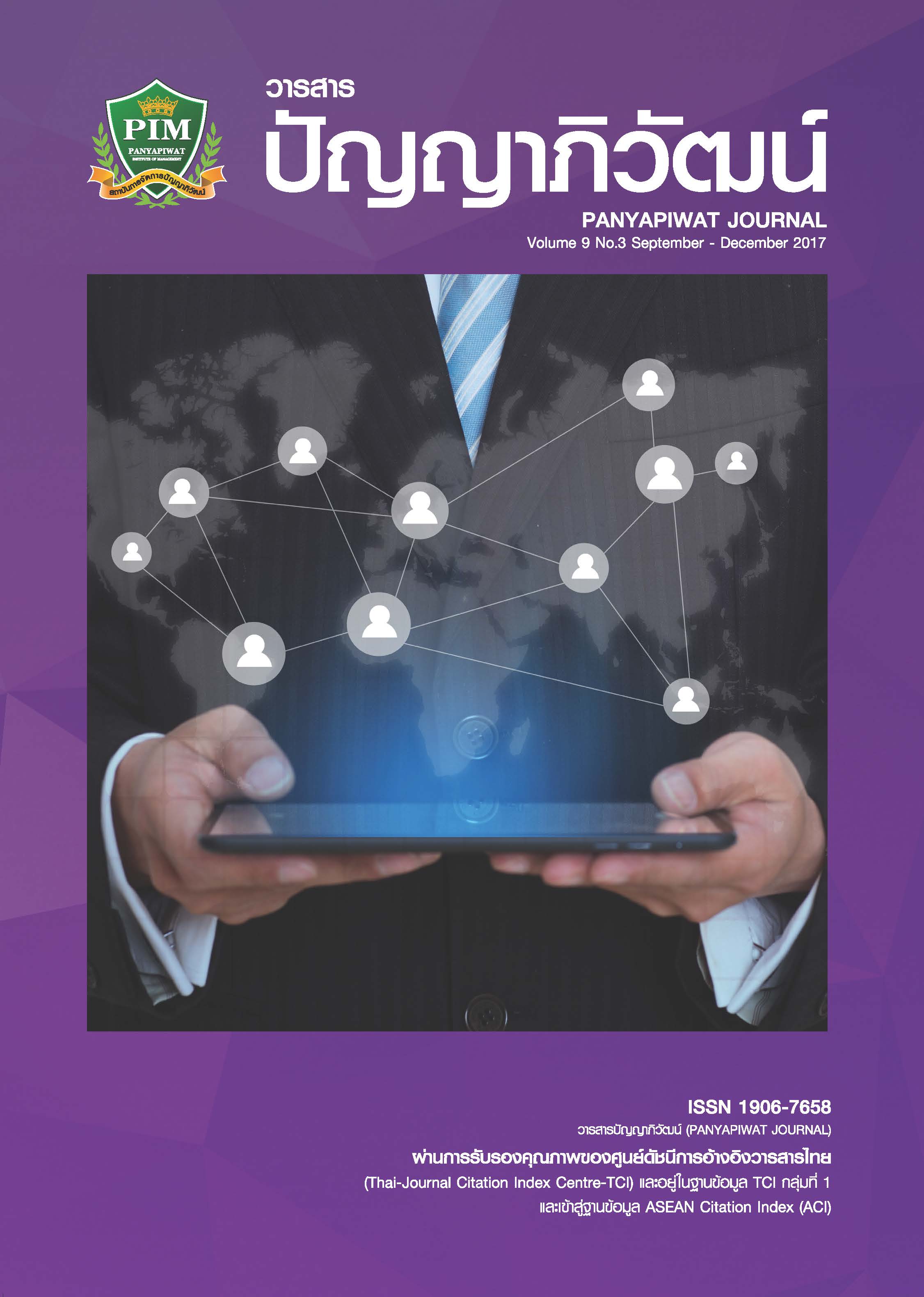การเปรียบเทียบผลของการเรียนแบบร่วมมือเทคนิค STAD กับการเรียนโดยการบรรยายปกติที่มีต่อผลสัมฤทธิ์ทางการเรียนเรื่อง ที่ดิน อาคาร อุปกรณ์ และค่าเสื่อมราคา ในรายวิชาการบัญชีสินทรัพย์
Main Article Content
บทคัดย่อ
การวิจัยครั้งนี้มีวัตถุประสงค์เพื่อเปรียบเทียบผลสัมฤทธิ์ทางการเรียนหลังเรียนวิชาการบัญชีสินทรัพย์ หัวข้อที่ดิน อาคาร อุปกรณ์ และค่าเสื่อมราคาของนักศึกษาคณะบัญชีชั้นปีที่ 2 ระหว่างกลุ่มที่เรียนแบบร่วมมือเทคนิค STAD กับกลุ่มที่เรียนโดยการบรรยายแบบปกติ กลุ่มตัวอย่างคือนักศึกษาคณะบัญชี ชั้นปีที่ 2 มหาวิทยาลัยกรุงเทพ จำนวน 146 คน แบ่งเป็นกลุ่มทดลองที่เรียนแบบร่วมมือเทคนิค STAD จำนวน 78 คน และกลุ่มควบคุมที่เรียนโดยการบรรยายปกติจำนวน 68 คน เครื่องมือที่ใช้ในการวิจัยคือ แผนการจัดการเรียนหัวข้อที่ดิน อาคาร อุปกรณ์ และค่าเสื่อมราคาจำนวน 8 แผน แผนละ 3 ชั่วโมง รวม 24 ชั่วโมง เก็บรวบรวมข้อมูลจากแบบทดสอบวัดผลสัมฤทธิ์ทางการเรียน แบบทดสอบนี้เป็นปรนัย 4 ตัวเลือก จำนวน 19 ข้อ ค่าดัชนีความสอดคล้อง (IOC) = 0.85 และค่าความเชื่อมั่นโดยใช้สูตรของ Kuder-Richardson (K-R20) มีค่าเท่ากับ 0.81 สถิติที่ใช้ในการวิเคราะห์คือ ค่าเฉลี่ย ส่วนเบี่ยงเบนมาตรฐาน สถิติทดสอบที และการวิเคราะห์ความแปรปรวนร่วม (ANCOVA)
ผลการวิจัยพบว่า ผลสัมฤทธิ์ทางการเรียนหลังเรียนวิชาการบัญชีสินทรัพย์หัวข้อที่ดิน อาคาร อุปกรณ์ และค่าเสื่อมราคาของนักศึกษาคณะบัญชีชั้นปีที่ 2 กลุ่มที่เรียนแบบร่วมมือเทคนิค STAD สูงกว่ากลุ่มที่เรียนโดยการบรรยายปกติอย่างมีนัยสำคัญทางสถิติที่ระดับ .05 (F = 31.03*, p = 0.00) โดยมีคะแนนเฉลี่ยหลังเรียนวิชาการบัญชีสินทรัพย์หัวข้อที่ดิน อาคาร อุปกรณ์ และค่าเสื่อมราคาด้วยวิธีการเรียนแบบร่วมมือเทคนิค STAD มีค่าเฉลี่ยเท่ากับ 12.87 คะแนน และการเรียนโดยบรรยายปกติมีค่าเฉลี่ยเท่ากับ 9.71 คะแนน
This study aimed to compare the learning achievement of the students who had taken the topic of property, plant, equipment and depreciation in asset accounting class. The samples included 146 second year accounting students of Bangkok University. The samples had been divided into 2 groups. The experimental group included 78 students participating in the STAD cooperative learning technique. The control group included 68 students participating in the normal lecture technique. Research instrument were 8 learning plans (3 hours of each plan). The data was collected from achievement test which had 19 multiple choice questions. The index of item–objective congruence (IOC) and reliability by using Kurder-Richard (KR-20) of this achievement test were 0.85 and 0.81. The data was analyzed by using mean, standard deviation, t-test and analysis of covariance (ANCOVA).
Results revealed that the learning achievement of the students who had participated in the STAD cooperative learning techniques performed better than those who had participated in the normal lecture. The results were significant at .05 level (F = 31.03*, p = 0.00). The mean score for the cooperative learning group (12.87) was higher than that of the normal lecture group (9.71).
Article Details
“ข้าพเจ้าและผู้เขียนร่วม (ถ้ามี) ขอรับรองว่า บทความที่เสนอมานี้ยังไม่เคยได้รับการตีพิมพ์และไม่ได้อยู่ระหว่างกระบวนการพิจารณาลงตีพิมพ์ในวารสารหรือแหล่งเผยแพร่อื่นใด ข้าพเจ้าและผู้เขียนร่วมยอมรับหลักเกณฑ์การพิจารณาต้นฉบับ ทั้งยินยอมให้กองบรรณาธิการมีสิทธิ์พิจารณาและตรวจแก้ต้นฉบับได้ตามที่เห็นสมควร พร้อมนี้ขอมอบลิขสิทธิ์บทความที่ได้รับการตีพิมพ์ให้แก่สถาบันการจัดการปัญญาภิวัฒน์หากมีการฟ้องร้องเรื่องการละเมิดลิขสิทธิ์เกี่ยวกับภาพ กราฟ ข้อความส่วนใดส่วนหนึ่งและ/หรือข้อคิดเห็นที่ปรากฏในบทความข้าพเจ้าและผู้เขียนร่วมยินยอมรับผิดชอบแต่เพียงฝ่ายเดียว”
เอกสารอ้างอิง
Alijanian, E. (2012). The Effect of Student Teams Achievement Division Technique on English Achievement of Iranian EFL Learners. Theory and Practice in Language Studies, 2(9), 1971-1975.
Dejthongjun, S. (2015). The Study on Development of Learning Effectiveness of Students in Local Administration Subject: A Comparison of the Learning Effectiveness Using STAD (Student Teams Achievement Division) and Lecture. Retrieved December 1, 2015, from https://www.dpu.ac.th/dpurc/assets/uploads/public/2i8ipmxrxcu8w0sw8g.pdf [in Thai]
Experimental Research. (n.d.). Retrieved April 30, 2015, from https://home.dsd.go.th/kamphaengphet/km/information/RESECARCH/06Experimental_Research.pdf [in Thai]
Instructional Design. (2015). Constructivist Theory (Jerome Bruner). Retrieved May 1, 2016, from https://www.instructionaldesign.org/theories/constructivist.html
Johnson, D. W. & Johnson, R. T. (2009).An Educational Psychology Success Story: Social Interdependence Theory and Cooperative Learning. Retrieved May 1, 2016, fromhttps://www.researchgate.net/publication/228634517_An_Educational_Psychology_Success_Story_Social_Interdependence_Theory_and_Cooperative_Learning
Kammanee, T. (2010). Cognitive science teaching. The learning process is effective. Bangkok: Dansuthakarnpim. [in Thai]
Keramati, M. R. (2014). Effect of Student Team Achievement Division (STAD) on Academic Achievement of Undergraduate Psychology Students. International Journal of Educationand Applied Sciences, 1(1), 37-47.
Khan, G. N. & Inamullah, H. M. (2011). Effect of Student’s Team Achievement Division (STAD) on Academic Achievement of Students. Asian Social Science, 7(12), 211-215.
Kijrungreung, N., Satianyanon, W. & Chaodamrong, W. (2002). The Learners are Important and Professional Teachers write Lesson Plans. Bangkok: Satapornbooks. [in Thai]
Maheady, L., Harper, G. F. & Mallette, B. (2001). Peer - Mediated Instruction and Interventions and Students with Mild Disabilities. Remedial and Special Education, 22(1), 4-14.
Ministry of Education. (1999).National Educational Act of B.E. 2542. Bangkok: Prikwarn Graphic. [in Thai]
Nikon, F. R., Bonyadi, A. & Ebrahimi, K. (2014). The Effect of Student Team-Achievement Division (STAD) on Language Achievement of Iranian EFL Students across Gender. European Online Journal of Naturaland SocialSciences,3(4), 936-949.
Shabani, K., Khatib, M. & Ebadi, S. (2010). Vygotsky’s Zone of Proximal Development: Instructional Implications and Teachers’ Professional Development. English LanguageTeaching,3(4), 237-248.
Slavin, R. E. (1987). Cooperative Learning and the Cooperative School. Educational Leadership, 45(3), 7-13.
Slavin, R. E. (1991). Synthesis of Research on Cooperative Learning. Educational Leadership,48(5), 71-81.
Slavin, R. E. (2011). Instruction Based on Cooperative Learning. In R. E. Mayer & P. A. Alexander (Eds.). Handbook of Research on Learning and Instruction. New York: Taylor & Francis.
Suraporn, B. (2015). Learning Achievement in Studying Elementary Statistics and Satisfaction of the Students Using Student Teams Achievement Divisions (STAD). KKU Science Journal, 43(3), 552-563. [in Thai]
Suwantada, N. (2016). The effect of mathematic learning activities with a teams-games-tournaments (TGT) technique: a case study of pre-calculus project 2015. Panyapiwat Journal, 8(2), 144-152. [in Thai]
Van Wyk, M. M. (2012). The Effects of the STAD-Cooperative Learning Method on Student Achievement, Attitude and Motivation in Economics Education. Journal of Social Sciences, 33(2), 261-287.
Webster, J. & Hackley, P. (1997). Teaching Effectiveness in Technology-Mediated Distance Learning. The Academy of Management Journal, 40(6), 1282-1309.
Weerawatyothin, S. & Porntadavit, N. (2015). Use of Lesson Plans Based on STAD Cooperative Learning Model to Promote Achievement of Mathayomsuksa 4 Students on Traditional Thai Dance. Journal of Graduate Studies Valaya Alongkorn Rajabhat University, 9(3), 13-20. [in Thai]
Woerkom, M. V. (2004). The concept of critical reflection and its implications for human resource development. Advances in Developing Human Resources, 6(2), 178-192.


